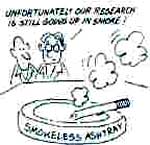Deceptive ashtrays
 SMOKERS enjoy that puff while non- smokers in their vicinity suffer health hazards for no fault of theirs. In recognition of the ill-effects of plumes of smoke emanating from a smouldering cigarette between puffi, smokeless ashtrays were designed. Research into the effectiveness of these supposedly public-friendly ash-trays may give its users a renewed prick in their conscience. A research team at the University of California led by David A Wampler tested 2 commercially available smokeless ashtrays. They found these to be highly ineffective in capturing and treating smoke from a cigarette, prior to its release in the environment. This conclusion was arrived at after scientists conducted chamber experiments to detect efficiency of these ashtrays in removing gas and particulate matter from cigarette smoke. They, however, reported that non-smokers' exposure to environmental tobacco smoke (FTS) did not diminish by these devices (The Journal of the Air and Water Management Association, June 1995).
SMOKERS enjoy that puff while non- smokers in their vicinity suffer health hazards for no fault of theirs. In recognition of the ill-effects of plumes of smoke emanating from a smouldering cigarette between puffi, smokeless ashtrays were designed. Research into the effectiveness of these supposedly public-friendly ash-trays may give its users a renewed prick in their conscience. A research team at the University of California led by David A Wampler tested 2 commercially available smokeless ashtrays. They found these to be highly ineffective in capturing and treating smoke from a cigarette, prior to its release in the environment. This conclusion was arrived at after scientists conducted chamber experiments to detect efficiency of these ashtrays in removing gas and particulate matter from cigarette smoke. They, however, reported that non-smokers' exposure to environmental tobacco smoke (FTS) did not diminish by these devices (The Journal of the Air and Water Management Association, June 1995).
Prior to these experiments, a sensory test was also performed for each device under normal operating conditions, where the mass of ETs particles deposited in a lung-deposition model was estimated. Much to the astonish- ment of the scientists, the level of deposition was found to be strikingly similar when the model was exposed to cigarette smoke, first with, and then, without the use of a smokeless ashtray. Scientists have attributed this ineffectiveness of smokeless ashtrays to the use of low-quality filter media, and also to the failure of these devices to draw the smoke through the filter. While suggestions like replacing low- efficiency filters with high-efficiency ones are being put forth by the researchers, they strongly advocate that development of effective smokeless ash- trays should be complementary to other ETS control measures, like prohibiting smoking in public places. While performance of the currently available smokeless ashtrays has disappointed researchers, there is still an optimism in the air that a reliable, high-efficiency, low-cost counterpart of these is possible in future.This ray of hope emerged when a prototype ashtray using a new filter material was fou 'n& to achieve 90 per cent particle removal efficiency.
